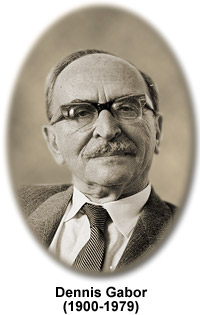Dennis Gabor
(1900-1979)

In the late 1940s, Dennis Gabor attempted to improve the resolution of the electron microscope using a procedure that he called wavefront reconstruction, but which is now known as holography. Though he was unable to realize his goal at the time, his work was to find much more prolific use years later, after the development of the laser in 1960.
Born in Budapest on June 5, 1900, Gabor was eldest of three sons. His mother had once been an actress and his father was a businessman that eventually became the director of the Hungarian General Coal Mines. The young Gabor pursued scientific inquiries at an early stage in his life, carrying out experiments he had read about in scientific periodicals at home in conjunction with one of his brothers. However, he did not immediately have the opportunity of formally pursing his interests, since he was called to serve the Austro-Hungarian army during World War I. Following the end of the war in 1918, Gabor embarked on an educational pursuit of mechanical engineering at the Budapest Technical University. Yet, before he could complete his third year, he was once again called to serve his country. This time he chose to leave Hungary rather than fight for a political body he did not support.
Moving to Germany, Gabor entered the Berlin Technical University to continue his education. While studying at the academic institution from 1920 to 1927, Gabor had the opportunity to work under such great minds as Albert Einstein and Max Planck, and emerged with a doctorate in engineering. After graduation, Gabor accepted a position as a research engineer for Siemens and Halske, a Berlin firm. Thus, he remained in Germany until Hitlerís rise to power, which led him to relocate in 1933 to England, where he began working at the British Thomson-Houston Company.
During his 15 years with the corporation, Gabor carried out the bulk of his work regarding electron microscopes. His efforts were directed at an increase in resolving power and in 1947 he thought he had found a solution. Gaborís idea was to take a distorted electron image, and then clarify that image via optical methods. To do this, he planned to split an electron beam into two, directing one of the resultant beams at the object to be imaged and the other at a mirror. Though both beams would initially be coherent and have the same wavelength, when they met at the photographic film interference patterns would occur due to their reflection from different surfaces. Then, if light were shone through the film, an image would be produced that was capable of being three-dimensionally reconstructed.
The practicality and usefulness of Gaborís theoretical and experimental findings were, however, limited in 1948 when they were first published in Nature. Having used a mercury lamp and a pinhole to produce inexact holograms and mathematically proven the feasibility of holography with electron beams, Gabor was plagued with the disappointment of being unable to create a commercially viable system. Due to the diffuseness of the light sources available at the time, the new method did little to improve the resolution of electron microscopes and even compounded the problem in the sense that two unclear images tended to be produced, instead of one.
The full impact of Gaborís work with three dimensional images, which he termed holograms after the Greek phrase for ďwhole message,Ē did not become apparent until the invention of the laser, which provided the intense, coherent light necessary for successful holography. In fact, only two years after Theodore Maiman produced the first workable laser, two graduate students studying at the University of Michigan created clear holograms based on Gaborís earlier work. Since that time, holograms have been used in increasingly diverse applications, most notably in the realm of security since they are virtually impossible to replicate.
Nevertheless, despite his inability to actualize his own successful holograms, Gabor left the British Thomson-Houston Company in 1949 when he was offered a faculty position at the Imperial College of Science and Technology at the University of London. He continued at the institution, where he developed a number of inventions along with several graduate students, until 1967. Though he was awarded over 100 patents and authored numerous works over the course of his lifetime, in his later years Gabor became increasingly concerned about the function of science and technology in society. His belief in the social responsibilities of scientists was even emphasized in his Nobel lecture, after he received the Nobel Prize in Physics in 1971 for his foundational holographic research and experimentation.
Three years after his crowning honor, Gabor suffered a stroke that rendered him unable to speak or write. Yet, as a testimony to his dedication and incredibly active mind, he was able to preserve a connection with his colleagues and to visit New Yorkís Museum of Holography when it was launched in 1977. His poor health, however, soon overtook him, and he passed away in London in 1979.
